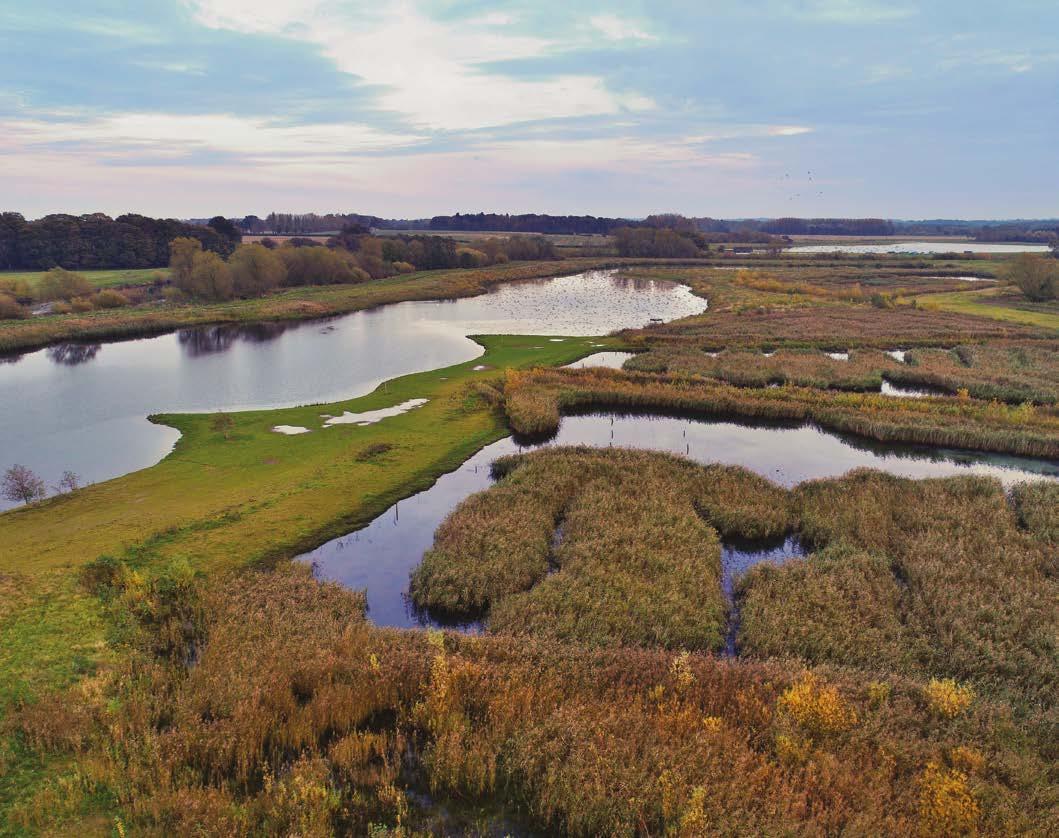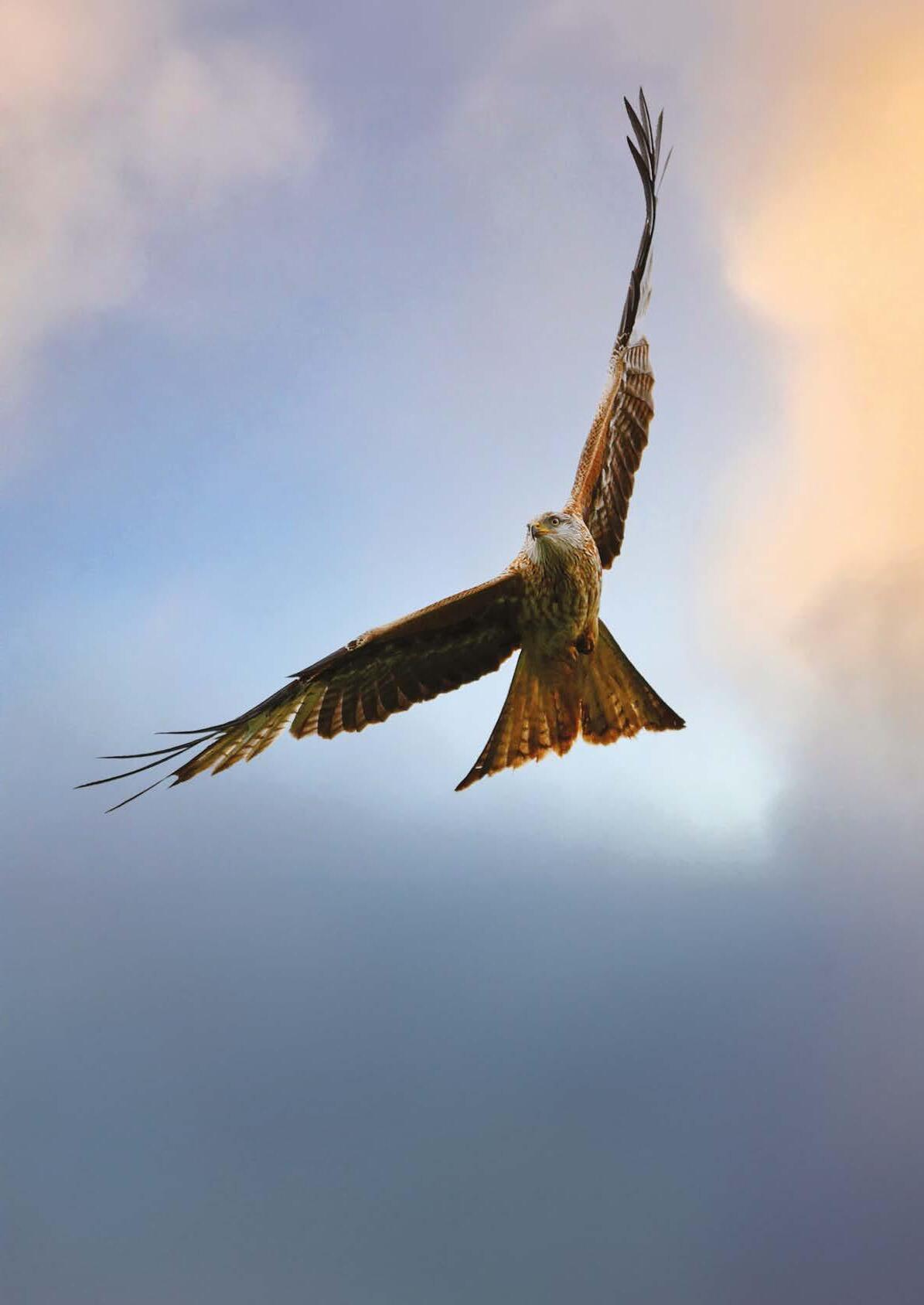Delivering Nature’s Recovery in Yorkshire
Our Annual Report for 2023/24

Yorkshire Wildlife Trust is the only charity entirely dedicated to conserving, protecting and enhancing Yorkshire's wildlife and wild places


Our Annual Report for 2023/24

Yorkshire Wildlife Trust is the only charity entirely dedicated to conserving, protecting and enhancing Yorkshire's wildlife and wild places

Welcome to our 2023-24 report as we present just some of our highlights from the past year. We remain committed and determined to drive nature’s recovery in Yorkshire, despite challenges from the rise in costs because human pressures on our wildlife remain high - and are increasing.
This report showcases the breadth of work we do for wildlife across Yorkshire’s great landscapes, along the network of water courses and stretching out into the North Sea. Our dedicated Peat, Wild Ingleborough and Marine and Wilder Humber programmes, continue to restore our vital ecosystems from the uplands to the coast, and from source to sea for a wilder Yorkshire.
Our teams work to help as many species as possible in diverse and dispersed places across the region, with a focus on networks for their recovery, with restoration and reintroductions benefitting a range of species and delivering services we all need.
Our achievements in wildlife conservation and protection are accomplished through team effort. Led by our strong, resilient and evolving staff, and so often only achievable with the additional effort made by our fabulous volunteers, with incredible support too from our members and funders. Our new
Directors and trustees
Trustees serving during the year are:
Prof. Alastair Fitter CBE
Gurdev Singh
Joanna Webb
Martin Randle
Paddy Hall (to Oct 23)
Richard Tripp (to Oct 23)
Nick Perks
Dr Mick Armitage
Peter Meadows
Dr Ceri Williams
Nabil Abbas
Michael Graham
Dr Jane Smart OBE
Officers of the Trust
President
Prof. Sir John Lawton
Patrons
Stephen Martin OBE
#TeamWilder approach puts people and communities at the heart of nature’s recovery.
We are interconnected with the UK and the Crown Dependencies, as a member of The Wildlife Trusts’ federation. Our work as an active contributor to the collaborations and ambitions at national level pays dividends for Yorkshire’s wildlife and residents.
Finally, to everyone who has supported us in whatever way in the past year – thank you. Your support is vital for us to continue our work to meet our ambitions for wildlife, so we may all have a secure future.
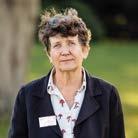

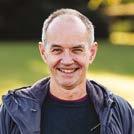

Chair of the Board
Joanna Webb
Company Secretary
Nick Perks
Honorary Treasurer
Martin Randle (to Oct 23)
Dr Mick Armitage (from Oct 23)
Directors of Yorkshire Wildlife
Services Limited
Darren Tiffney
Christine Packer (to Nov 23)
Pete Meadows (from Nov 23)
Yorkshire Wildlife Trust
Charity number 210807.
Company number 00409650
Yorkshire Wildlife Services Limited
Company number 09922108
Registered and Principal Office
1 St. George’s Place, York, YO24 1GN
Legal Advisors
Harland & Co, 18 St Saviourgate, York, YO1 8NS Auditors
Saffery LLP, Chartered Accountants and Registered Auditors, Mitre House, North Park Road Harrogate, HG1 5RX Bankers
Bank plc, 1 Parliament Street, York, YO1 8SE
Executive Officer
Rachael Bice
Deputy Chief Executive
Martin Slater
Director of Finance
Darren Tiffney
Director of Fundraising and Engagement
Amanda Spivack
Head of Human Resources
Jane Hamilton
Head of Nature Recovery
Sharne McMillan
42,311 members 22,142 memberships 85,000 magazines delivered 2,000 welcome calls made
1,370 donations processed - worth £436k 1,609 volunteers 52,761 volunteer hours (equivalent to 28 additional full time staff)
447 #TeamWilder sign ups 28+ local action groups actively supported
411 Wildlife Gardening Awards
For 78 years the Trust has brought people together to learn from, protect and support Yorkshire’s wildlife and wild places. Looking ahead to 2030, our work will be more urgent and important than ever before, as a driving force and beacon for nature’s recovery.
We want to see biodiversity and wildlife populations increase again, our natural systems returning to health, and residents and visitors alike to benefit from a healthier, more resilient natural environment.
Ambition 1
More land and sea positively managed for wildlife
Ambition 2
More people taking positive action for wildlife
Ambition 3
Active support for wildlife is embedded in the framework of society
19,527 people engaged (of which 9,493 were children) 652 engagement sessions
172 online and print articles with a ‘opportunity to see’ of 18.8 million with coverage 77 broadcast interviews
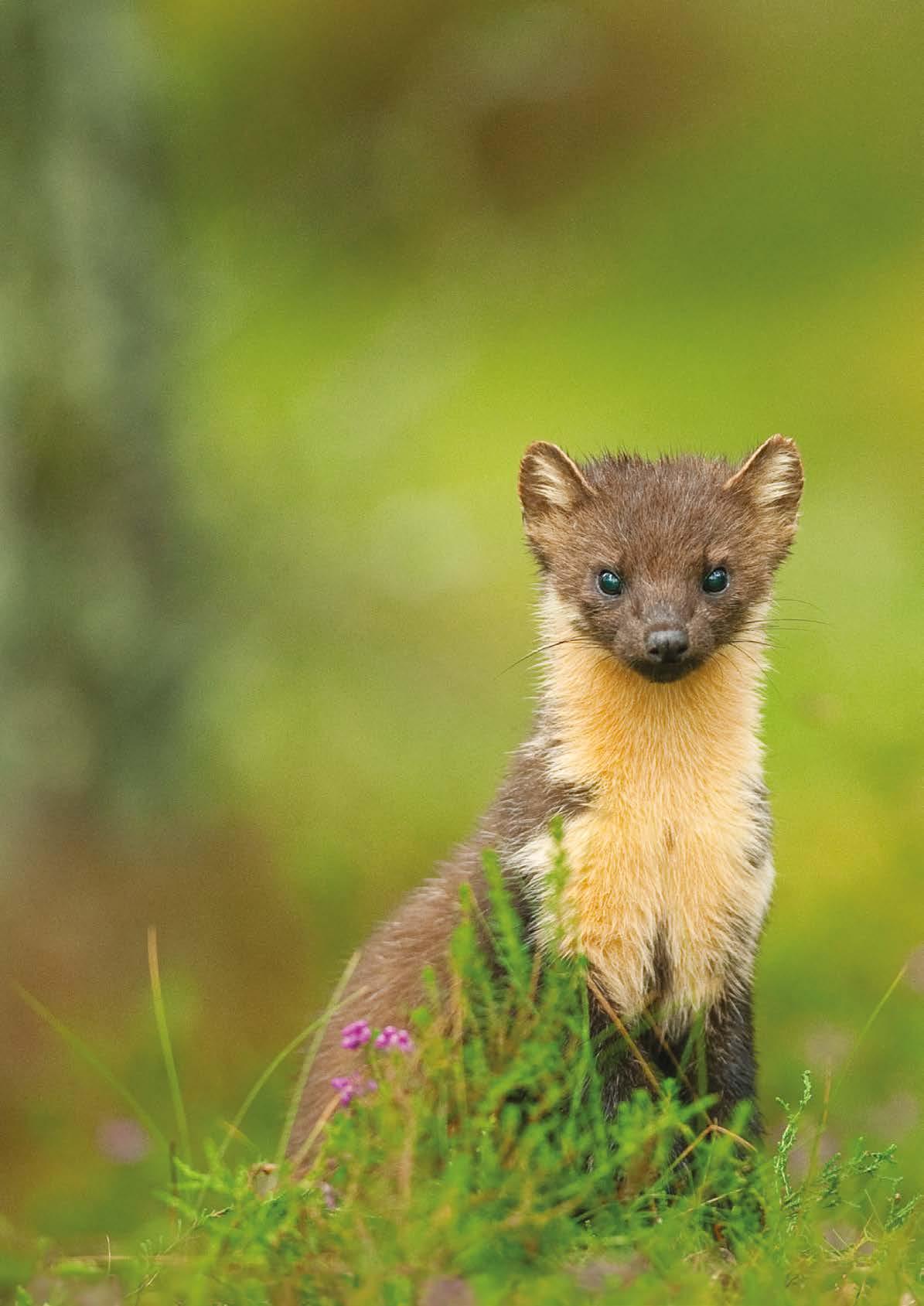
Your support for nature’s recovery is vital.

We’ve been working at landscape-scale to restore biodiversity and improve habitats, from our incredible peatlands and Dales uplands to our precious network of rivers.
Yorkshire Peat Partnership restore peatland soils for habitat, atmospheric carbon reduction and slowing the movement of water.
Another 4,084 ha were brought into restoration in the uplands this year.
Almost 750,000 cotton grass, crowberry and sphagnum plants were planted to slow the flow of water through 157 km of eroding channels: the nearequivalent length of the entire river Aire.
Species Recovery Programme funding has been awarded to investigate the potential for reintroducing white-faced darter dragonflies back into our lowland peat bogs.
Cumulatively, 42,868 hectares of peat have now been restored: an area the size of Bradford.
In south Yorkshire, our team are carefully restoring internationally important lowland peatlands, an excellent example of a lowland raised mire and a haven for breeding nightjars:
n The Humberhead Peatlands comprise Thorne, Goole, and Crowle Moors, as well as Hatfield Moors, and represent the largest area of raised bog wilderness in lowland Britain at 2,887 hectares in size.
n Following surveys last year, restoration work was carried out on the lowland peatlands in the Humberhead Levels with support of the Nature for Climate Fund. Water levels across the landscape needed to be more effectively managed to ensure the peatland can regain its functional integrity.
n To enable this, two new 2 retrofit tilting weirs were fitted on to existing steel pile dams and 570m of ditches were cleared.
Our Wild Ingleborough programme continues, approaching the end of the first phase restoration with more land in recovery, extensive numbers of montane trees planted and several landowners involved in the care of this much loved Dales landscape.
Woodland recovery:
Another 31,591 native trees were planted to re-establish the natural tree line and habitats across the mountainside, with the help of 1,018 volunteer hours
Conservation grazing:
An essential part of conservation grazing is the upkeep of our boundaries to keep our livestock in and neighbouring livestock out. In 23/24 we repaired 100m of drystone walls with the help of 592 volunteer hours.
Species recovery:
We started collecting wildflower seed to propagate and grow on in our nursery including the rare and isolated species purple saxifrage, spiked speedwell and globeflowers. We’ve been propagating the rare holly fern in a novel way too, by collecting spores into a spray bottle, mixing with water and spraying directly onto suitable areas of limestone pavement, helping to establish it into new areas around Ingleborough. We are already seeing early green shoots of success.
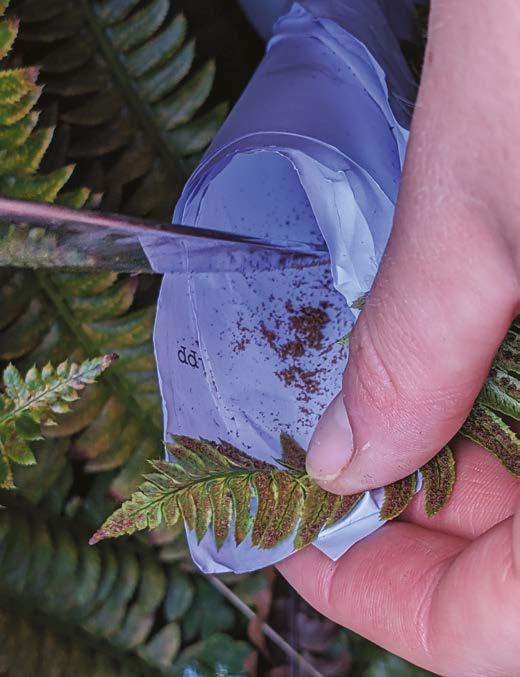

in Malhamdale
In Spring 2023, 35 children from two local primary schools took part in a project with Wild Ingleborough focussing on ground nesting birds. The work earned them a John Muir Discovery Level Award. Studying Ingleborough, the habitats found there and the different types of birds that make the area their home, the children designed a campaign to raise awareness about the vulnerability of ground nesting birds. Their focus was curlews, their risk of extinction and the need to take action to protect them. The children became passionate advocates for ground nesting birds, sharing their message in school assemblies and in a special presentation to parents at the Victoria Hall in Settle. Children from Kirkby in Malham wrote poems about ground nesting birds for their literacy work, two of which won prizes in the charity Curlew Action’s World Curlew Day poetry competition
Teacher John Bell said:

“The project has been an excellent experience for the children and a great way for them to learn about a local issue with global significance. Most importantly, it has taught them practical ways that they can make a difference”
n The Yorkshire Derwent Catchment Partnership has continued ongoing restoration work, with 54km of riverbank treated to control giant hogweed, a species which is not rare enough! We also restarted the Foss Catchment Partnership project – which looks to reverse some of the rivers’ decline. The project works with farmers to improve water quality by reducing the amount of sediment and pollution entering the watercourse, mitigating flood risk using natural flood management techniques throughout the Foss catchment, and improving habitat for the river Foss wildlife. The Foss Operations Group works with over 25 partner organisations and tackles issues including invasive species.
n The Reviving Calderdale’s Rivers project was a 12-month partnership project between Yorkshire Wildlife Trust, the Wild Trout Trust and Calder & Colne Rivers Trust. The project was funded by the Environment Agency and Yorkshire Water and looked at restoring and improving riparian sites throughout the Mid-Calder catchment. Amongst other work, several tonnes of rubbish were removed from Hebble Brook, and willow spiling (a living willow wall) was installed along two farmers’ fields to prevent erosion. A population of endangered white-clawed crayfish were also rediscovered at Luddenden Brook as part of the project, previously thought extinct in the area.
n The river Swale suffers from a lack of or disconnected floodplains, decreasing wetland space, and pollution from agricultural run off. The goal of the mid-Swale project is to restore, enhance and recreate these vital habitats, and we have been working with local landowners to do this whilst also reducing agricultural run-off and potentially lowering flood risk.
This year we have restored three ponds located on farmland adjacent to the Swale, as well as improved their margins for wildlife whilst maintaining the original brick and stone lining. We have created areas of new wetland along the river, reseeding the margins with a local wetland grass mix then fenced to prevent damage by livestock. We have reintroduced purple loosestrife and ragged robin to improve degraded wetland areas. Finally, we hosted a talk to raise awareness to landowners discussing the importance of soil health and how to farm in a more wildlife friendly manner – as well as the added benefits it could make to the land and their finances.
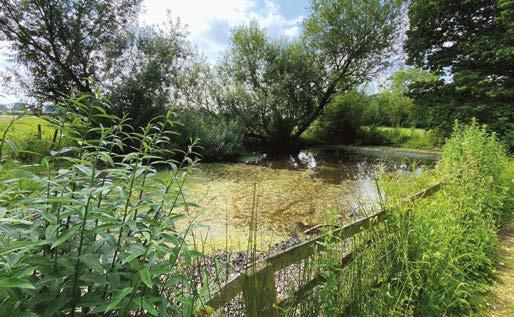
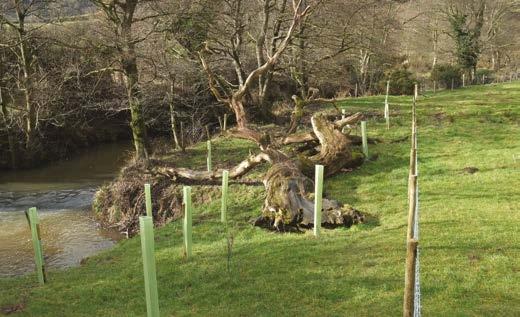
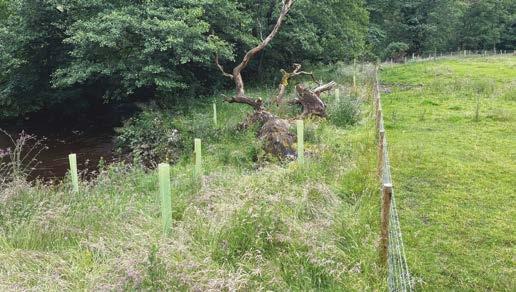
n Dynamic Drains: Dynamic Drains is a project exploring Kingston-UponHull’s rich history and relationship with its drainage system. Alongside the Environment Agency, Hull City Council and Groundwork, we hope to inspire communities to take action and help protect Hull’s watercourses, with new interpretation produced by our design team and trail cameras giving an insight into the area’s more hidden wildlife.
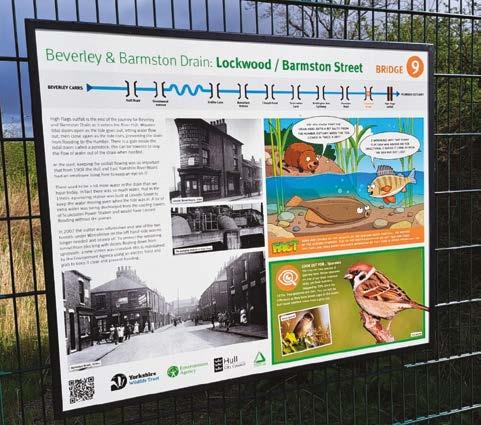
Our nature reserves contribute to a network for nature’s recovery across the region, as we restore and create new habitat. We are always delighted when our reserves provide space for some of our favourite species to rest, feed and breed. This year’s highlights from our portfolio of 111 nature reserves included;
Eagled eyed recorders at Potteric Carr rediscovering rare water beetle Berosus luridus, last recorded in 1937 and thought locally extinct.
Water germander, last found in Yorkshire in 1863, was successfully reintroduced to Boltonon-Swale with ongoing monitoring in place.
In the Lower Derwent Valley, the Yorkshire Derwent Catchment partnership planted new areas of tansy across several reserves to encourage populations of the rare and brilliantly coloured tansy beetle, as well as the rare greater water parsnip at Wheldrake Ings.
A mother otter with cubs were spotted for the first time in 60 years at Wheldrake Ings.
Conservation grazing with sheep and ponies improved habitat at Potteric Carr, resulting in little ringed plover breeding alongside two pairs of bitterns and two pairs of willow tits
A secretive water rail visited Adel Dam nature reserve for the first time.
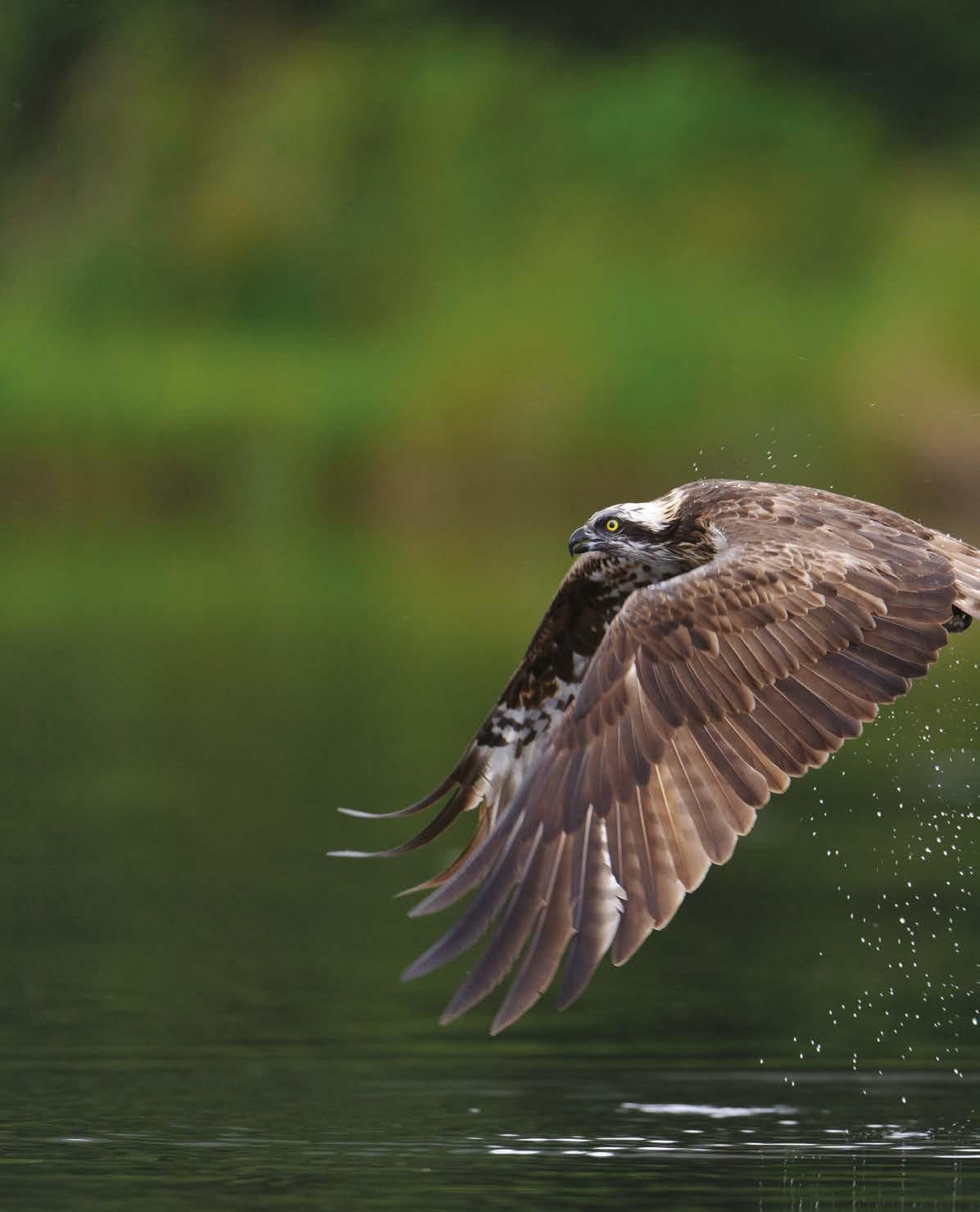
We try to ensure our reserves are accessible for as many people as possible. This year at Hetchell Wood, we resurfaced approximately 200m of public footpath, installed a brand new 57m handrail, a new retaining wall was built for a spring, and around 140 brash bundles were installed across the craggy slope to combat erosion.
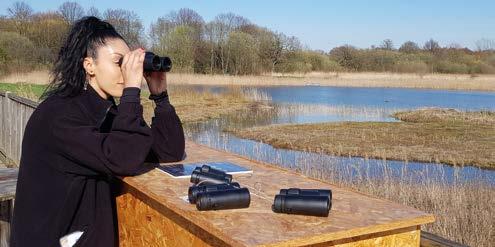
Much of the work achieved on reserves for wildlife and for access is enabled by the incredible support we receive from volunteers. Over 1000 amazing people gave over 50,000 hours of their time this year to help care for the reserves and the Trust’s wild places. 96% said they would recommend volunteering for the Trust.
Our teams also work with other landowners to ensure some of our most vulnerable species can survive and, where possible, thrive in Yorkshire.
n One of the most difficult jobs this year was the management of Avian flu at North Cave Wetlands: unfortunately 40% of the nationally-important black headed gull colony there was lost. However, thanks to brave and quick action by our staff who collected over 1000 dead birds, the spread of the disease was minimised and the remaining birds did not succumb to the virus. A number of chicks fledged, and figures this year have improved with over 800 breeding birds returning in spring 2024.
n Little terns had a record-breaking nesting season on the beaches around Spurn where we work closely with Spurn Bird Observatory. SBO reported 107 fledging from 58 nesting pairs thanks to factors including improved habitat and reduced disturbance.
n Work continued to support the critical population of white-clawed crayfish surviving in North Yorkshire, and we began work with Flamingo Land to develop a crayfish hatchery, which will restore populations over the coming years.
n Establishing rare plant populations is a foundation for nature’s recovery. This year we have seen the first flowering lady’s slipper orchids in the colony we reintroduced. By installing rabbit fencing, we preserved the first flower spikes of greater butterfly orchid seen at Ellerburn Bank for several years. While only a handful of these beautiful plants flowered, we are delighted that they cling on and will work to maintain and increase the population.

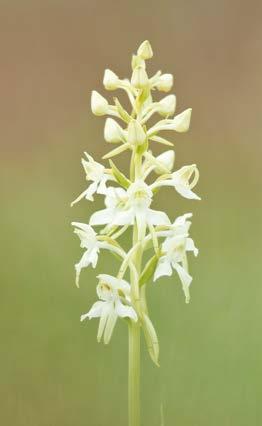
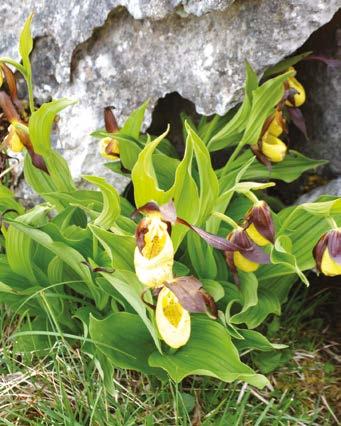
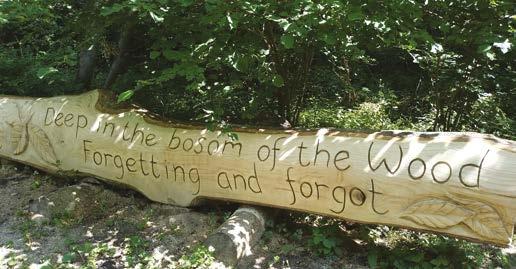
Ash dieback continues to be an issue on our woodland reserves and across the UK. We assess and fell dead and dying trees to keep our sites safe – but it’s having a huge impact on our time and resources. We are monitoring the progress of the disease and will report on how our woodlands are responding to the management works in the coming years.
However, challenges can also bring opportunities. Thanks to funding from North Yorks Moors National Park Authority we commissioned a thought-provoking installation by local artist Steve Iredale. Carved into the side of a felled ash tree, it can be seen by all visitors walking the Coast to Coast National Trail which passes through Little Beck Wood. The intention is to prompt a moment of reflection on our relationship with the natural world.
The summer of 2023 saw the North Sea reach temperatures 5 degrees above average. This climate change-induced pressure on our marine life makes our restoration work all the more important. This year:
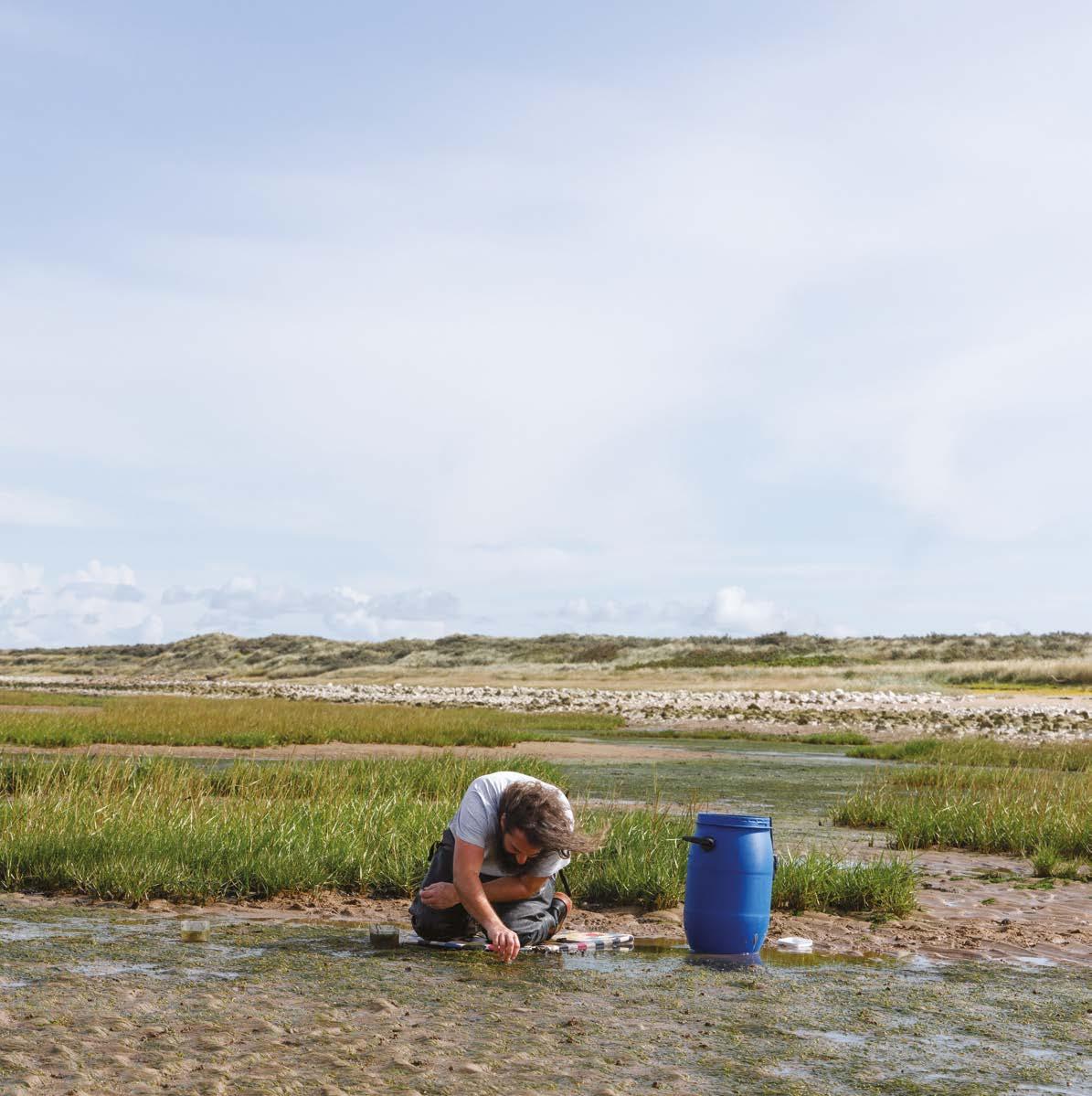
We planted over 15,000 seagrass seed bags into the Humber estuary mudflats, covering an area of 10 hectares.
As we inspire and educate more people about Yorkshire’s marine life, there are more eyes looking out to sea. This year, a pod of 35-40 bottlenose dolphins were sighted at Spurn Point in September, and four common dolphins at Runswick bay which is very rare for that area of coastline.
We continued to restore the European flat oyster population there; 40,000 adult and juvenile oysters are now growing on trestles in the Humber estuary.
Other unusual visitors included a sunfish and basking shark off Flamborough Head - perhaps just passing though, or possibly harbingers of climate change.
Our dedicated Waves of Waste volunteers undertook 55 beach cleans on 6 of the most critical beaches for wildlife along the Yorkshire coast.
Engaging people to care about the wonderful wildlife in the North Sea and around our coastline takes many forms. This year over 7500 people joined events run by our Wild Eye partnership across Scarborough and Whitby, taking part in seaweed searches and cyanotype workshops, seafood cookery classes and attending marine wildlife.
As the year progressed, we continued to draw together the evidence for the State of Yorkshire’s Nature report, and work on the development of our strategic approach to nature recovery – both due for completion in 2024/25. Meanwhile work on the ground and in our local networks continued:
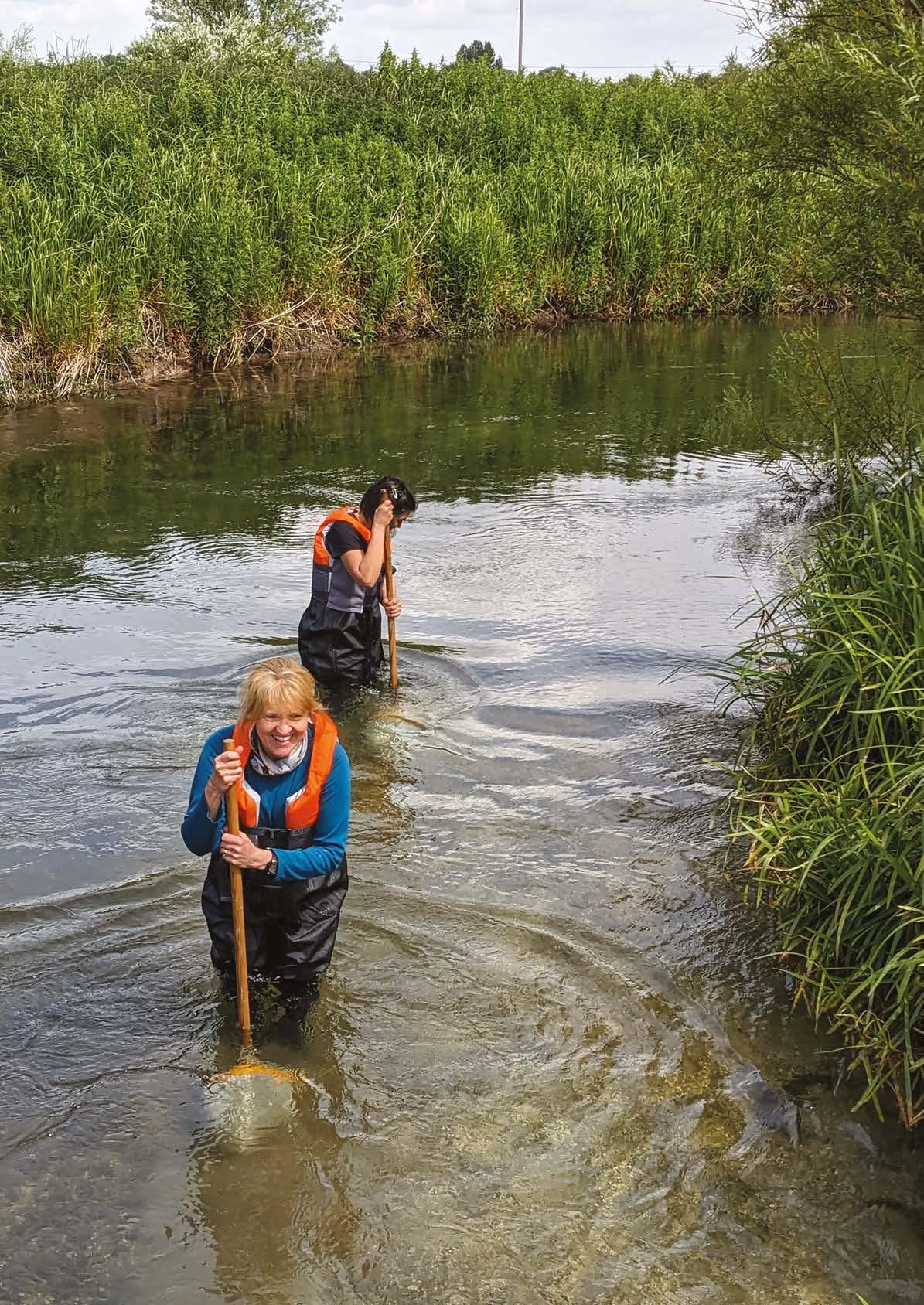
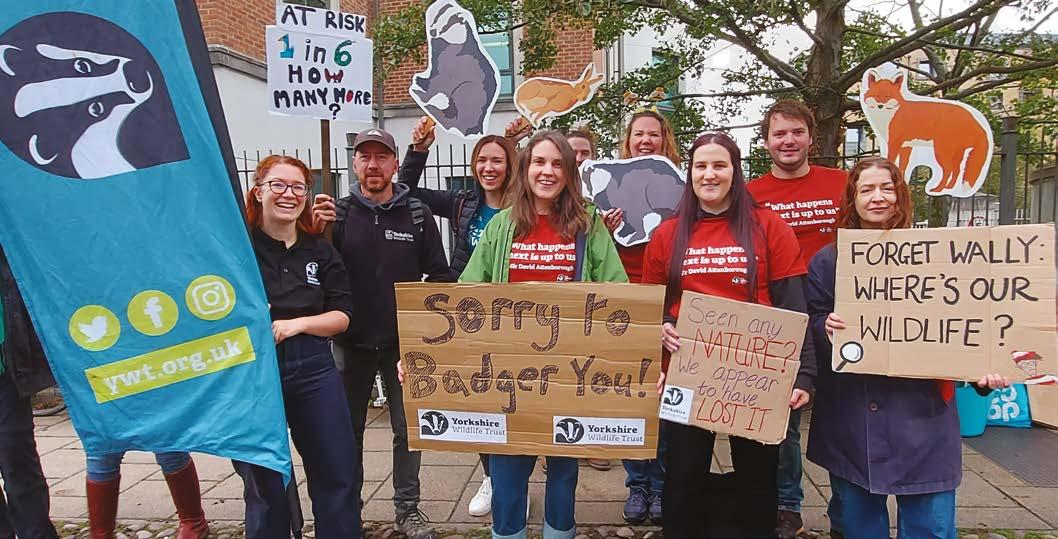
n Our teams continued to advance the practical methods of data collection for conservation to improve our impact. A new approach on the River Hull catchment was developed to systemise data collection and establish more volunteer water quality surveyors.
n Our Invasive Non-Native Species (INNS) team launched the refreshed UK INNS Mapper – an app and website for the reporting of sightings, surveys and management of INNS across England, Wales and Scotland. The Mapper is free to use and aims to provide an effective resource to support INNS programmes and coordinate efforts.
n We used eDNA sampling to evaluate the success of the new ponds created under the District Licencing Scheme for Great Crested Newts which we implement for Natural England. We discovered newts were living in 9 of the 37 ponds created the previous year, which is a 24% success rate – the precise national average, and a very promising sign.
n We continued to engage in the Planning System to speak up for the wildlife across Yorkshire, using a new prioritisation system to ensure we use our resources to have the most impact. This new system resulted in more effective advocacy, with 18/90 applications with YWT comments considered in the planning officer reports, compared to 1/588 in 22/23.
n A particular success was at Paull Holme Strays, where our advice and evidence to the Planning Committee meeting
n Our teams began the engagement in each combined authority area to support the production of these documents. We facilitated a successful workshop event, bringing together wildlife organisations from across Yorkshire to explore partnership working opportunities to drive nature’s recovery in Yorkshire, so our collective voice could be more powerful than the sum of our individual parts. At the workshop we focused on what nature absolutely needs from the LNRS process so we could have a clear collective voice when speaking to local government.

resulted in the rejection of a damaging development proposal for a new caravan park at Fort Paull next to our reserve.
n We mobilised to #DefendNature, as environmental protections and concerns continued to be marginalised by the Government. We attended the Defend Nature Rally in York, to stand up for the Nutrient Neutrality regulations in September and to raise awareness of nature’s decline reported in the National State of Nature report.
n We developed a relationship with North Yorkshire Council’s Highways team regarding their verge management regime. This is developing into a full workstream around other linear habitats, looking at how their management can be positively influenced to be better for wildlife.
n We continued to work with the Yorkshire and Humber Climate Change Commission to meaningfully address the nature and climate crisis, completing phase one of the Commissions work and helping to design phase two which will focus on land and water use planning. These are essential if we are to co-exist successfully with other species in future.
n The General Election loomed, and we began preparation to be ready for it to be called during 2024. This included several staff attending the Federation conference in September, focused on mobilising the movement for ensuring nature was in mind during the local and national Elections in 2024.
Driving understanding of and enthusiasm for Yorkshire’s incredible wildlife remains a vital part of our work to aid nature’s recovery.
n We want our members and visitors to have positive experiences at our reserves and completely updated our nature reserves guide this year. Discover Yorkshire’s Wildlife includes a whole host of new information including spotters guides, best-for guides for families, accessibility, birdwatching and fungi, revised reserve information, seasonal walks, and information about our broader approach to nature conservation.
n We know that inspiring and encouraging people to connect with and learn more about wildlife will mean more people taking more positive action for wildlife. This is central to our engagement activity. Our new #TeamWilder initiative connected with over 400 individuals, groups and educators to create new green wildlife corridors, community allotments, wildlife friendly rugby grounds, and village wildflower meadows. Some of these Groups are also liaising with local Parish Councils to develop and implement local sustainable land management plans, and our Wildlife Gardening Award was awarded to over 400 people, businesses and community groups across Yorkshire.
n Our programme of public engagement events are helping to inspire and encourage people to learn and care more for wildlife and wild places. This year we have engaged over 10,000 adults and 9,500 children through 652 sessions, which have offered a range of digital and in-person experiences. Throughout the year we offered a mix of paid for and complimentary events to ensure our engagement work is both generative and accessible.
n Once again Cliff the Puffin delighted his fans at the biggest and best Puffin Festival yet at Flamborough in May 2023, with 847 event participants and several hundreds more in visitors to the festival. We are grateful to Yorkshire Coast BID for their financial support to make this event possible.
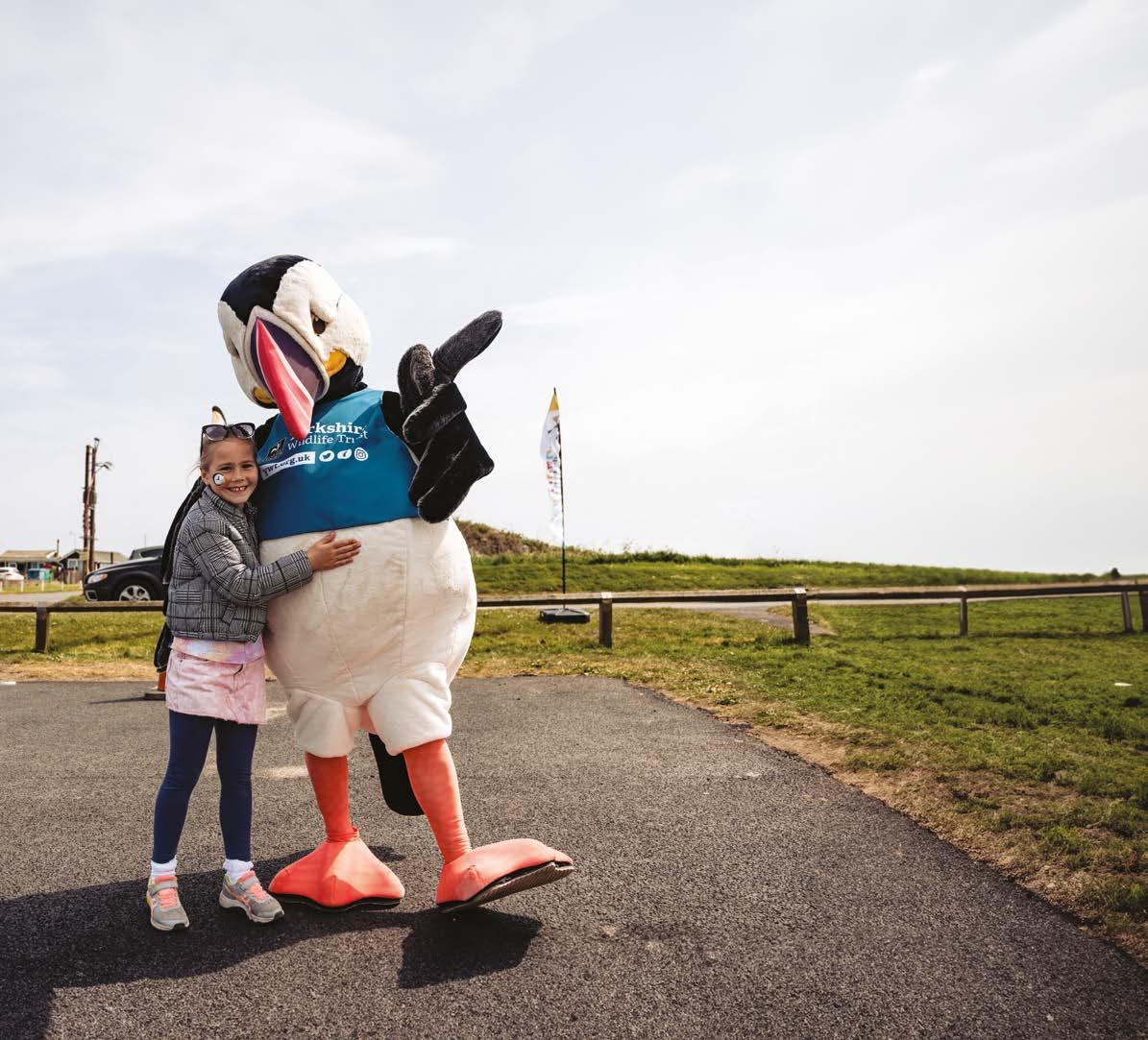
Thank you to our generous supporters
We want to say a huge heartfelt thanks to everyone who has joined us to help wildlife this year.
To our members - your loyal support means the world to Yorkshire’s wildlife, we’re so grateful for all the things you make possible, and we want to continue to make you proud to support us every day.
Thank you to our amazing volunteers
1,609 amazing volunteers gave over 52,000 hours of their time to help care for the reserves and the Trust’s wild places, this is 15% increase on last year and equivalent to an additional 28 full time staff.
98% of our volunteers say volunteering improves their wellbeing and 96% of current volunteers would recommend working with us.
268 individuals attended training from the Volunteer Programme, nearly 100 more than last year.
A highlight of the year was the 40th anniversary celebration at Grass Wood, volunteers have been pivotal over many decades to the protection and growth of the reserve, and the recent management of ash die back which will over time create a new ecological phase in the woodlands life story.

Thanks also to our legacy pledgers: Gifts in Wills provide a significant and critical source of income and enable us to make significant progress in protecting and restoring wildlife and wild places in Yorkshire. This year we dedicated an In Memory bench at Brockadale nature reserve to Brian Robertshaw; a dedicated volunteer who left a considerable legacy gift to the Trust. Unrestricted legacies provide a secure foundation for all our achievements for wildlife, and we are grateful to everyone who left a Gift in their Will. Our specific thanks are extended to Jean Dalby; Phillis Rockcliff; Arthur Clayton Wilson; Clive Mills Hicks; MJ Bulman; Eileen Allannach; Kenneth Horner; Elizabeth Baker; M Bower.
Our generous grant funders continued to support our work this year. Grants from the LNER Customer and Community Investment Fund, FCC Communities Foundation, Allison Willis Charitable Trust, Hull and East Riding Charitable Trust and Bruce Wake Charitable Trust supported us to undertake vital works for people and wildlife across our nature reserves. Funding from the A&N Daniell Trust was secured to support our wetland restoration work along the mid-Swale, and a grant from the Ørsted East Coast Community Fund has enabled us to install solar provision at our Living Seas Centre in Flamborough. We were grateful to secure funding again from the People’s Postcode Lottery to support a broad range of work across Yorkshire, including our work to inspire and engage with local communities and volunteers through our events programme and volunteering task days.
To our individual donors and corporate supporters, thank you for your substantial support this year; financially, through volunteering, and sometimes in kind. It was lovely to see so many of you at the various events across the year.
We would like to acknowledge the individuals and Trusts who so generously supported our fundraising appeals last year.
We have identified Staveley and North Cave Wetlands as reserves in need of strategic investment to meet the needs visitors, and improve the potential for wildlife.
Thanks to the generosity of many local supporters and some Trusts, we raised £21,847 for improvements to visitor experience at North Cave. And thanks to generous supporters we raised £20,158 to invest in visitor infrastructure and enhance habitats at Staveley. Both nature reserves have a very exciting future ahead, which future generations will benefit from.
Finally, we would like to extend grateful thanks to everyone who has already supported our Wild Ingleborough campaign. Our two-year fundraising campaign has got off to a fabulous start, with £36,000 raised through our Members in the first month of the campaign. We look forward to sharing more successes at Wild Ingleborough with you, as we restore the landscape to wild abundance.

Corporate members and supporters create generative partnerships with us; through donations, affinity giving, sponsorship, Gifts in Kind, engagement events and Wild Work Days.
A warm welcome to our new corporate members:
Birds Eye, Colt Construction, Integrated Utility Services, Might Fine / The Serious Sweet Company, Elms Farming, Mone Bros, Rounton Coffee and Termrim Construction.
Our new corporate supporters:
Hiscox, Tadcaster Benefice, Good Food Traders, Mute Animation Studio, The Davies Foundation, Tong Garden Centre, Forbidden Planet, Zizzis, With Many Roots, Wynsor Shoes, Stage One, John Good Group, Ecology Building Society, Hull Trains, Yorkshire Hideaways, Think Cloud Inc, Pocklington School, Ingrid Flutes/ Travel Chapter, Unit 3 Compliance and Fresh Cut Creative.
We appreciate the ongoing support from a wide range of Yorkshire’s businesses who value our work – thank you.
Gold Members:
Birds Eye Ltd
Colt Construction Ltd
Dr Reddy’s Laboratories (EU) Ltd
GB Railfreight Ltd
Harmony Energy Ltd
H C Slingsby PLC
Jay-Be Ltd
University of Leeds
Wykeland Ltd
The Symphony Group PLC
Silver Members:
Close Brothers Group PLC
Integrated Utility Services
Lightrock Power Ltd
Might Fine / The Serious Sweet
Company Ltd
TOG24 / Mileta Sports Ltd
The Bio-D Company Ltd
University of York
Aviva PLC
Consulo Financial Planning Ltd
Croda International PLC
Dalesbred Ltd
Double Two Ltd
Elms Farming
Evans Property Group Ltd
Far ‘n’ Beyond Ltd
Forest Holidays Group Ltd
Friendship Estates Ltd
Henry Boot PLC
Inntravel Ltd
Mone Brothers Ltd
North Wolds Richardson Group Ltd
Peppers Maquees Ltd
Read Family Group Ltd
Reed Boardall Group Ltd
Rounton Coffee Ltd
Sloemotion Distillery Ltd
Syngenta Ltd
Tennants Auctioneers Ltd
Termrim Construction Ltd
Xiros Ltd
Airedale International
Andrew Bennett Wildlife Photography
Cloud Kickers
Banks Group
Beechfield Brands
Castle Howard
Ecology Building Society
Forbidden Planet
Fresh Cut Creative
Good Food Traders
Hull Trains
Ingrid Flute’s/ The Travel Chapter
John Good Group
Hiscox
Mute Animation Studio
Pocklington School
Puffins Galore
Stage One
Tadcaster Benefice
The Davies Foundation
Tong Garden Centre
Think Cloud Inc
Thornwick Bay / Haven
Unit 3 Compliance
Umbellifer
Vp plc
Whitby Distillery With Many Roots
Wynsor Shoes
Yorganics
Yorkshire Hideaways
Yorkshire Water / Kelda Group
Zizzis
Despite the continuing challenge to public and household finances, we have delivered a financially stable organisation with an increased turnover of £14.03m, another record year for the Trust. Our finance team and trustees have worked together to oversee this performance and to ensure we have the reserves necessary to support the increased scale of organisation and programmes of work, and carefully manage our risks.
The trustees of Yorkshire Wildlife Trust are pleased to present their Annual Report and the Consolidated Audited Accounts for the year to 31st March 2024.
We consolidated our recent achievements, with ambitious large-scale programmes of landscape restoration. Our reserves continue to play an important role in supporting the increased scale of the organisation and our programmes of work, whilst allowing us to carefully manage our risks.
This is made possible through the combined work of our whole staff team, who also need services and support, including secure digital systems. This year we formed a three-year plan in our organisational development journey and improved terms and conditions for staff, increasing annual leave, sickness pay and family related leave provisions. We attended to improvements needed at our offices, completing works at the Blue Bell at Spurn and leased a new space in Pickering.
The trustees also confirm that they have complied with their duty to have due regard to the guidance on public benefit published by the Charity Commission in exercising their powers or duties. Annual Report and consolidated accounts are also prepared to meet the requirements for a directors’ report and accounts for Companies Act purposes.
The trustees, who are also directors of the charity for the purposes of the Companies Act, have adopted the provisions of Accounting and Reporting by Charities: Statement of Recommended Practice, applicable to charities preparing their accounts in accordance with the Financial Reporting Standard applicable in the UK and Republic of Ireland (FRS102) (Effective 1 January 2019). Income £14,037,645
We remain focused on our financial management and fundraising activities to ensure that the Trust has the resources it needs. Our finances have faced challenges this year due to continued inflationary pressures on resources, in conjunction with challenges arising from land subsidy income reductions and delays to new agricultural subsidy programmes. We have also continued to make important investments in our IT infrastructure and adequately resourcing our central functions to establish efficient, safe and effective ways of working.
Our financial outturn for 23/24 shows a net movement in funds of an increase of £446,452, however, with a reduction in the general unrestricted funds account of (£142,722).
We are once again proud to partner with agencies such as Natural England, the Environment Agency, local and national government to deliver landscape-scale restoration projects. We hope to build on these relationships with the introduction of green financing opportunities.
Our fundraising portfolio of activity continues to grow with corporate partners increasingly interested in funding our landscape and seascape scale work. Our focus this year has been to inspire hearts and minds across Yorkshire and we ran a public engagement campaign with Heart FM in May to reach into new audiences.
With a focus still on critically-important wetland habitats, we ran some localised appeals, to fund improvements to two of our most popular reserves: Staveley and North Cave Wetlands. We were granted £46,285 from the FCC Communities Foundation, supported by £20,158 donated from the public, which will help to fund a programme of
Yorkshire Wildlife Trust is committed to reach carbon net zero by 2030, and strives to embed best practice and adopt a holistic approach to carbon reduction through its work, people and activities.
We are continuing to evolve our measurement in this area. The table shows Scope 1 &2 emissions over which we have more control, including electricity and heating, transportation at work and our conservation grazing herd of livestock. These are shown in both absolute terms, and relative to our growing size. We also monitor indirect Scope 3 emissions associated with staff commutes, home working and, most recently, procurement. The data shows our actual emissions from 2019 – 2023, estimated emissions for 23/24 and the target forecast for 24/25.
While we have made progress in some areas, there is more work to do to reduce our operational emissions. YWT also contributes towards net zero through some of our habitat work, such as peat and seagrass restoration, and through encouraging members, supporters and partners to take action for climate and nature.
improvements to both habitat and visitor experience at Staveley. Our similar local focus at North Cave raised £11,347 from our supporters, £10,500 in grants and £10,000 from an individual, all which will be invested in visitor infrastructure. We were able to install a new wildlife watching hide in Memory of Dennis Wood thanks to a generous donation from the Smith family. We are incredibly grateful to everyone who has donated to secure a bright future for these muchloved reserves.
We are delighted to continue our affinity partnership with silver business members TOG24 with Whitby Gin on their Navy Strength gin and with Ingrid Fluke Holiday cottages; and to have a new partnership with Yorganics and Rounton Coffee. We also received significant donations in year from Yorkshire Water, Hiscox, Cloud Kickers and 1% for the Planet which has enabled us to continue our work on Yorkshire’s peatlands, wetlands and our local nature reserves.
The support we continue to receive from our business members, partners and funders has helped us to fund and carry out vital work across our nature reserves and wild landscapes. This includes a generous donation from the Puffins Galore art trail around the East coast, and project support and Wild Work Day participation from many local businesses and partners including the University of Leeds, Aviva and Novuna.
We have been fortunate in recent years to receive funds in legacies, which this year totalled £579,283 for which we are humbly grateful. Gifts in Wills remain a critical funding source in enabling us to achieve significant steps to protect and restore wild places and wildlife for future generations.
We are nature’s voice when nature has none. We will continue to advocate for Yorkshire’s nature on the broadest possible scale; working extensively across land, river and sea, partnering with councils, landowners and communities, and encouraging love for nature with future generations.
We remain focused on ensuring the ambitious Local Nature Recovery Strategies that Yorkshire’s nature needs are created.
We will deliver our innovative programme of nature recovery; from the uplands, through our catchments, to the coast and into our offshore marine environment. We will continue to care for our precious reserves and their wildlife, and will encourage more people to mobilise for nature, particularly increasing opportunities for young people.
We want our voice for nature to be heard strongly throughout Yorkshire and in Westminster as the new Government takes shape. As a result, we will share our stories everywhere – with our supporters, the media and in communities - so that we can drive action on climate and ecological breakdown.
Together, we can create a wilder Yorkshire.
